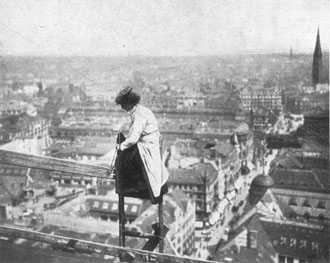Despina Stratigakos
A Women’s Berlin: Building the Modern City
University of Minnesota Press
256 pages, 7 x 10 inches
ISBN 978 0816653232
ISBN 978 0816653225
Around the turn of the twentieth century, women began to claim Berlin as their own, expressing a vision of the German capital that embraced their feminine modernity, both culturally and architecturally. Women located their lives and made their presence felt in the streets and institutions of this dynamic metropolis. From residences to restaurants, schools to exhibition halls, a visible network of women’s spaces emerged to accommodate changing patterns of life and work.
A Women’s Berlin retraces this largely forgotten city, which arose in the years between German unification in 1871 and the demise of the monarchy in 1918 and laid the foundation for a novel experience of urban modernity. Although the phenomenon of women claming urban space was widespread in this period, Berlin’s concentration of women’s building projects produced a more fully realized vision of an alternative metropolis. Female patrons called upon female design professionals to help them define and articulate their architectural needs. Many of the projects I analyze in the book represent a collaborative effort uniting female patrons, architects, and designers to explore the nature of female aesthetics and spaces.
At the same time that women were transforming the built environment, they were remaking Berlin in words and images. Female journalists, artists, political activists, and social reformers portrayed women as influential actors on the urban scene and encouraged female audiences to view their relationship to the city in a radically different light. Women’s remapping of Berlin connected the imaginary to the physical, dreams to asphalt, and inextricably linked the creation of the modern woman with that of the modern city.

Seeing the familiar landscape of the city vanish under the onslaught of industrial urbanization, many women glimpsed their liberation and joined the fray, helping to construct the new Berlin with the zeal of the converted.
Over the past decade, a series of books has examined women’s claims to urban space at the turn of the twentieth century as integral to the rise of the modern city. Most such accounts have been written by scholars of urban literature and social historians. The topic has been broached rarely by architectural historians, with the result that buildings have largely dropped out of consideration in analyzing how women created a public presence for themselves in the modern city. As an architectural historian, I seek to refocus attention on the built environment, particularly on the importance of architectural language, in the gendered appropriation of urban spaces. Paying close attention to the choices made by builders and patrons, I demonstrate how women in Berlin employed architectural language to create specific and meaningful identities for themselves as public citizens. Architecture became a medium through which women expressed contested notions of modernity in a language shared and understood by Berliners. Reading buildings as carefully coded texts, I hope to make apparent the significance of visual and spatial representations to marginal urban populations seeking a metropolis that recognized and accommodated difference.
Architecture does more than signify, however, and I am equally concerned with understanding how it reshaped gendered experiences, particularly the experience of the public sphere. A Women’s Berlin pays special attention to monumental projects, such as the Victoria Studienhaus, a residential center for university women that was designed by Emilie Winkelmann and created a new model for the German academic experience. Monumentality challenged cultural precepts that forbade “respectable” women to be visible in the city. Big buildings constituted an explicitly disruptive urban presence, boldly refuting traditional conceptions of women’s proper place. Their monumentality declared that women would not be contained but would instead expand upward and outward into the public spaces of urban life.
This desire to express one’s modern identity through buildings also suggests a very different strategy from that adopted by the flâneur. The phenomenon of women building their modernity into the very fabric of the city underscores, as sociologist Janet Wolff has argued about literature, the insufficiency of notions of subjectivity that emphasize disembodied engagement or ephemerality as a universal response to the experience of modernity, a position exemplified in the writings of urban commentators such as Georg Simmel, Karl Scheffler, and Hans Ostwald. These male critics, lamenting the instability of modern life, voiced one reaction—to be sure, shared by many Wilhelmine Germans—to the capital’s unruliness. Not all Berliners, however, took a pessimistic view of urban dislocation. Seeing the familiar landscape of the city vanish under the onslaught of industrial urbanization, many women glimpsed their liberation and joined the fray, helping to construct the new Berlin with the zeal of the converted.
As visionary builders, constructing an alternative way of being in the city, Berlin women rejected a homogenizing view of modernity and defined their experiences in relation to the concept of difference. A Women’s Berlin seeks to understand how they marked difference in spatial and architectural terms. Surprisingly, the rise of a more explicitly gendered landscape undermined the fixity of separate spheres for men and women, a model that historians and political theorists reject as simplistic and misleading. Instead of presenting us with a clear and deep divide, a women’s Berlin proves both more permeable and edgier: Women pressed against traditional boundaries, crossing over into a “man’s” world, while also erecting new barriers that protected and nurtured their evolving urban identities. The Victoria Studienhaus, which allowed women to participate more fully in German academic life, but on their own terms, is an apt example. Such architectural interventions pursued neither integration nor separation but something more fluid and dynamic.
A woman builder making repairs to the roof of Berlin’s town hall, 1910. From Illustrierte Frauenzeitung 38, no. 2 (1910): 17.

The first image in the book depicts a woman builder making repairs to the roof of Berlin’s town hall. Balanced on a ladder high atop the city, this young woman physically intervenes in the urban built environment with her hands and tools. A dense and vibrant urban landscape unfolds beneath her. This extraordinary photograph, taken in 1910, succinctly captures the phenomenon of brave new vistas appearing before women. As part of a series that documented women in male professions, the image associated the ascent of women to new occupations with the vertical rise of Berlin, linking female modernity directly to that of the city itself.
Readers of the Illustrierte Frauenzeitung, a popular Berlin fashion magazine, encountered this striking image of a female builder amid pages devoted to elegant hats and dresses. The accompanying text introduced her as the first woman to undertake the demanding practical training required for this profession and emphasized the “great deal of courage and self-confidence it takes to stand on a ladder at this height in female clothing and, at the same time, perform a difficult task; in any case, however, this activity should be recommended only to vertigo-free ladies” (1910). While depicting the new horizons opening up to women, then, the magazine’s editors conveyed a sense of danger pertaining to the female body and its clothing. If her skirt did not snag, the subtext seemed to say, plunging a woman to her death hundreds of feet below, her mental instability (the supposed female tendency to swoon) might lead to a similar ruin. This message, a warning to “lesser” women not to follow in the path of exceptional (and perhaps aberrant) pioneers, was at variance with the calm assurance displayed by the builder. This same confident attitude permeates the chapters of A Women’s Berlin. The book reveals how women refused to be intimidated by prevalent tales of urban danger and other forms of social and legal harassment, constructing new urban narratives and spaces that embraced an open and optimistic attitude toward urban life and the modern woman.

Remapping of Berlin connected the imaginary to the physical, dreams to asphalt, and inextricably linked the creation of the modern woman with that of the modern city.
A Women’s Berlin rewrites the history of one of Europe’s great modern cities through the lens of women’s urban spaces, both imaginary and physical. The Berlin that emerges in these chapters is at once familiar and strange: We recognize the street names, but the maps look different. Place and gender intersect to produce fresh accounts of the city and new meanings in the contested process of modernity. In 1910, Karl Scheffler, alienated by the ceaseless pace of change in the German capital, declared that Berlin was condemned forever to become and never to be. We can and should expect no less of its history, and the story of a women’s Berlin, which interweaves architectural and gendered struggles, encourages us to look anew at the complex making and remaking of a modern metropolis.
A city reimagined and reshaped by women is too vast an entity to be contained in a single book. In selecting themes, buildings, and narratives, I have concentrated on those that highlight an awareness of the role of the urban built environment in the creation of a modern female identity. While I believe the resulting picture is representative, it is by no means exhaustive. More work remains to be done, particularly in understanding women’s physical imprint on the urban fabric. I hope this study acts as a guidebook, sufficiently intriguing readers to prompt further explorations in archives and books and on the city’s streets.




We don't put paywalls. We don't distract you with ads. We don't sell your data.
Please help to keep this running!